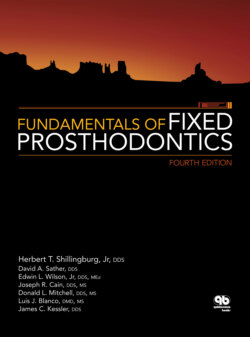Читать книгу Fundamentals of Fixed Prosthodontics - James C. Kessler - Страница 24
На сайте Литреса книга снята с продажи.
Diagnostic casts
ОглавлениеDiagnostic casts are an integral part of the diagnostic procedures necessary to give the dentist as complete a perspective as possible regarding the patient’s dental needs. To accomplish their intended goal, the casts must be accurate reproductions of the maxillary and mandibular arches, made from distortion-free alginate impressions. The casts should contain neither bubbles as a result of faulty pouring nor any positive nodules on the occlusal surfaces ensuing from air entrapment during the taking of the impression.
To derive maximum benefit from the diagnostic casts, they should be mounted on a semi-adjustable articulator. When they have been positioned with a facebow and the articulator adjustments have been set using lateral interocclusal records, a reasonably accurate simulation of jaw movements is possible. The articulator settings should be included in the patient’s permanent record to facilitate resetting the instrument when restorations are fabricated for this patient at a future date. Finally, the mandibular cast should be set in a relationship determined by the patient’s optimum condylar position (with the disc interposed) to better enable a critical occlusal analysis.
Articulated diagnostic casts can provide a great deal of information for diagnosing problems and arriving at a treatment plan. They allow an unobstructed view of the edentulous spaces and an accurate assessment of the span length as well as the occlusogingival dimension. The curvature of the arch in the edentulous region can be determined, which enables prediction of whether the pontic(s) will act as a lever arm on the abutment teeth.
The length of abutment teeth can be accurately gauged to determine which preparation designs will provide adequate retention and resistance. The true inclination of the abutment teeth also becomes evident; as a result, problems in a common path of insertion can be anticipated. Mesiodistal drifting, rotation, and faciolingual displacement of prospective abutment teeth can also be clearly seen.
A further analysis of the occlusion can be conducted using the diagnostic casts. The difference between the centric relation position and the intercuspal position should be noted. A thorough evaluation of wear facets—their numbers, size, and location—is possible when they are viewed on casts. Occlusal discrepancies can be evaluated, and the presence of centric relation prematurities or excursive interferences can be determined. The relationship of the anterior teeth and the anterior guidance can be viewed and analyzed. Discrepancies in the occlusal plane become very apparent on the articulated casts. Teeth that have supererupted into opposing opposing edentulous spaces are easily spotted, and the amount of correction needed can be determined.
Situations calling for the use of pontics that are wider or narrower than the teeth that would normally occupy the edentulous space require a diagnostic wax-up. Changes in contour plus widening or narrowing of an abutment tooth can also be tried and evaluated on a duplicate of the original cast. This enables the dentist and the patient to see how a difficult treatment will look when finished. The diagnostic wax-up, done in ivory wax, allows the patient to see all of the compromises that will be necessary.
It is far better to discover that the projected result is unsatisfactory to the patient before treatment is begun. If the patient is satisfied and the work proceeds, the wax-up will help the dentist plan and execute the preparations and the provisional restorations.
